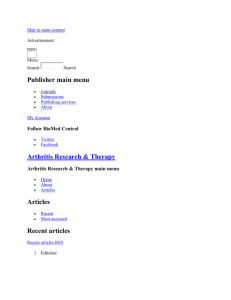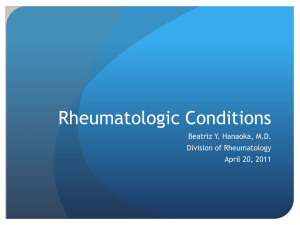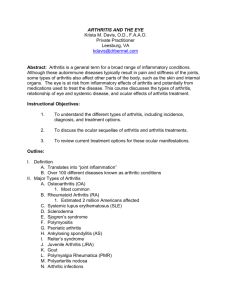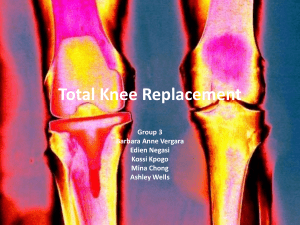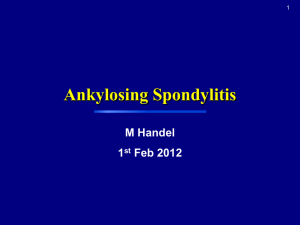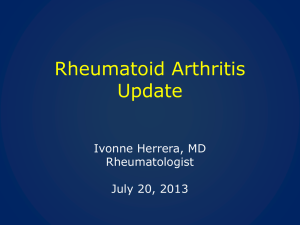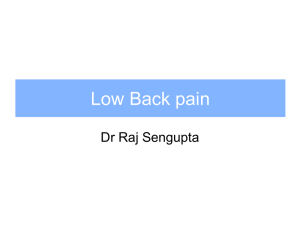Pain with or without swelling and stiffness at one or a few
advertisement
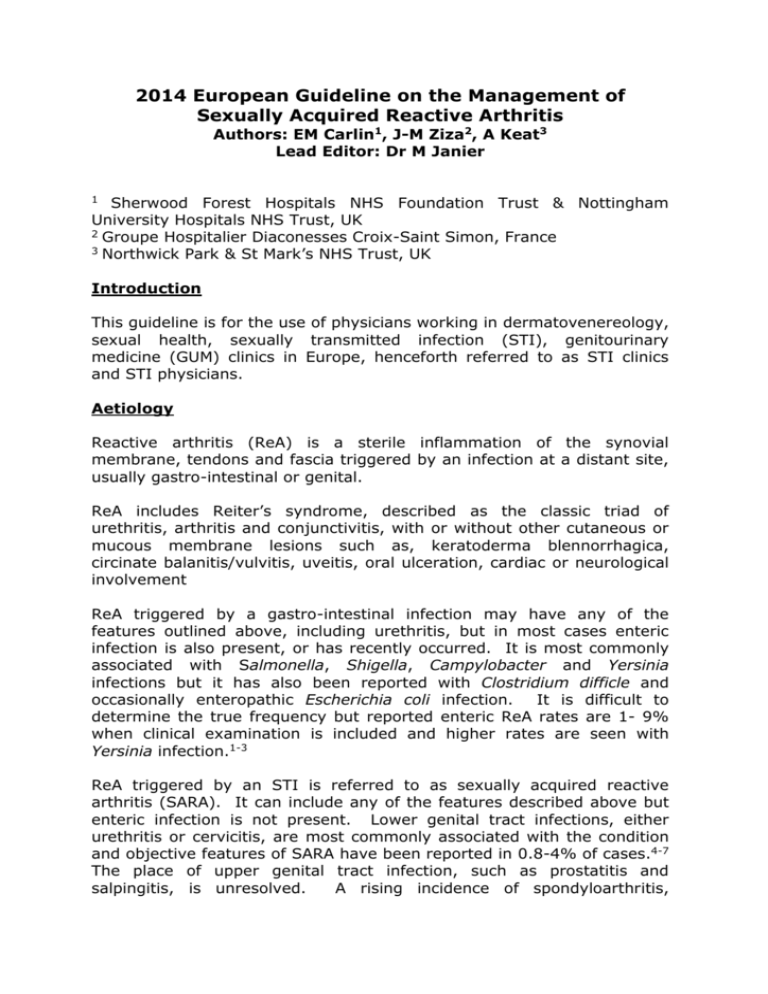
2014 European Guideline on the Management of Sexually Acquired Reactive Arthritis Authors: EM Carlin1, J-M Ziza2, A Keat3 Lead Editor: Dr M Janier Sherwood Forest Hospitals NHS Foundation Trust & Nottingham University Hospitals NHS Trust, UK 2 Groupe Hospitalier Diaconesses Croix-Saint Simon, France 3 Northwick Park & St Mark’s NHS Trust, UK 1 Introduction This guideline is for the use of physicians working in dermatovenereology, sexual health, sexually transmitted infection (STI), genitourinary medicine (GUM) clinics in Europe, henceforth referred to as STI clinics and STI physicians. Aetiology Reactive arthritis (ReA) is a sterile inflammation of the synovial membrane, tendons and fascia triggered by an infection at a distant site, usually gastro-intestinal or genital. ReA includes Reiter’s syndrome, described as the classic triad of urethritis, arthritis and conjunctivitis, with or without other cutaneous or mucous membrane lesions such as, keratoderma blennorrhagica, circinate balanitis/vulvitis, uveitis, oral ulceration, cardiac or neurological involvement ReA triggered by a gastro-intestinal infection may have any of the features outlined above, including urethritis, but in most cases enteric infection is also present, or has recently occurred. It is most commonly associated with Salmonella, Shigella, Campylobacter and Yersinia infections but it has also been reported with Clostridium difficle and occasionally enteropathic Escherichia coli infection. It is difficult to determine the true frequency but reported enteric ReA rates are 1- 9% when clinical examination is included and higher rates are seen with Yersinia infection.1-3 ReA triggered by an STI is referred to as sexually acquired reactive arthritis (SARA). It can include any of the features described above but enteric infection is not present. Lower genital tract infections, either urethritis or cervicitis, are most commonly associated with the condition and objective features of SARA have been reported in 0.8-4% of cases.4-7 The place of upper genital tract infection, such as prostatitis and salpingitis, is unresolved. A rising incidence of spondyloarthritis, 2 including ReA, in association with the human immune deficiency virus (HIV) has been seen in sub-Saharan Africa, although this does not appear to be the case in Caucasian populations.8-10 The precise mechanisms linking infective agents with SARA are not clearly understood so links with specific micro-organisms are partly speculative. Chlamydia trachomatis, the commonest identifiable cause of nongonococcal urethritis (NGU), has been the micro-organism most strongly linked to SARA being identified in 35-69% of cases, using nonnucleic acid amplification tests (NAAT).5,11-16 Neisseria gonorrhoeae has been linked with up to 16% of cases, as distinct from its role in septic, gonococcal arthritis.4,17-20 The precise role of this micro-organism in relation to SARA remains unknown. Ureaplasma urealyticum has been linked with a few cases and may be a cause of SARA in a minority.21,22 A causal role for other genital tract pathogens and commensals is possible but there is currently insufficient evidence for evaluation. Mechanisms of pathogenesis in SARA are not completely elucidated but appear to involve an immune response to uro-genital micro-organisms. DNA and/or surface antigens of C. trachomatis,13,23-29 U. urealyticum,28,30 and other mycoplasmas31 may be detected within joint material from individuals with SARA. It is likely that the persistence of viable microorganisms intra-articularly is an important factor in the causation and perpetuation of the arthritis. It has been shown in chlamydial infection that the organism develops into an unusual, persistent state in the synovium in an aberrant form with repressed synthesis of the major outer membrane protein (MOMP) and active production of heat shock protein (hsp), which contributes to the inflammatory response.32-34 SARA appears to occur over ten times more frequently in men compared to women, although under recognition in women may be a problem.3,4,20,35 Possession of the HLA-B27 gene increases susceptibility to SARA and is associated with increased severity of the condition.1,5,7,12,15,18,35 SARA is a ReA and can be associated with other spondyloarthritides; most commonly ankylosing spondylitis, sometimes psoriatic arthritis and rarely inflammatory bowel arthritis due to Crohn’s disease or ulcerative colitis. In some cases the ReA is complicated by ankylosing spondyloarthritis but the converse can also occur. 3 Clinical Features Epidemiological data suggests that SARA may be under or misdiagnosed.36 However, the following pointers will help clinicians to identify and diagnose the condition. It should be noted that most individuals with SARA do not have features of all three of the classic triad described earlier. History There may be a past or family history of spondyloarthritis, iritis, psoriasis, inflammatory bowel disease or SAPHO (synovitis, acne, pustulosis, hyperostosis, osteitis).3,4,7,19,37 Sexual intercourse, usually with a new partner, within 3 months prior to the onset of arthritis.5,12,35 Symptoms Onset of arthritis within 30 days of sexual contact in 88% of patients with a mean interval of 14 days between the onset of genital tract symptoms and arthritis.3,4,5,19,35 A recent history of urethral discharge and/or dysuria in approximately 80% of men with SARA, although considerably fewer women are symptomatic.12,14,19,20,35 Pain, with or without swelling and stiffness, at one or more (usually fewer than 6) joints especially at the knees, ankles and feet. The upper limb joints are much less commonly involved. The arthritis is usually asymetrical and is inflammatory with morning stiffness and nocturnal pain.1,3,7,16,19,35 Pain and stiffness at entheses, especially the posterior and plantar aspect of the heels, which often results in difficulty in walking. Enthesitis and/or fasciitis occurs in up to 40% of patients.3,4,16,18,20,35 Painful movements may also result in 30% from tenosynovitis and in 16% painful swelling of a toe or finger (dactylitis) may occur.3,16,35 Low back pain and stiffness is common in the acute episode. Sciatalgia and sacral pain, can occur and sacro-iliitis occurs in approximately 10% of patients during the acute episode.1,3,4,16,1820,35,38,39 4 Irritable eyes, with or without redness, photophobia or a reduction in visual acuity. Conjunctivitis occurs in 20-50% of patients with SARA, often bilateral and preceding the arthritis by a few days, but iritis is less common occurring in around 2-11% of patients.3,4,7,18-20,35,39 Other eye lesions occur rarely.4,18,20 Systemic symptoms of malaise, fatigue and fever occur in approximately 10% of patients.35 Physical signs Genital infection. Manifest in men by urethritis, urethral discharge and/or epididymo-orchitis and in women by mucopurulent cervicitis, with or without easily induced cervical bleeding, and/or abdominal pain. Infection may be 12,14,19,20,35 asymptomatic, particularly in women. Arthritis, almost invariably affecting 1-5 lower limb joints in an asymmetrical distribution. Persistent small joint involvement may be erosive. Upper limb involvement is rare in the absence of psoriasis.3,7,19,35 Enthesopathy. Tenderness, with or without swelling at the sites of tendon or fascial attachments, especially the Achilles tendon and plantar fascia attachments to the calcaneum.3,4,7,18,20,35 Tenosynovitis. Tenderness, with or without swelling over tendon sheaths and crepitus on movement. Classical dactylitis may be seen.3,35 Pain on direct sacral pressure may indicate acute sacroiliitis.3,4,18,20,35 Care should be taken to distinguish this from lumbosacral disc disease or hip involvement. Pain, irritation and redness of the eye is usually due to conjunctivitis, or rarely iritis.3,4,7,18-20,35,39 Slit lamp examination is required to differentiate between them but pain is more commonly a feature of iritis. Rarely, corneal ulceration, keratitis and intra-ocular haemorrhage may be seen and optic neuritis and posterior uveitis have been described.3,4,7,18,20 Psoriasiform rash which may be typical plaque or guttate cutaneous psoriasis in 12.5%,19 nail dystrophy in 6-12%,19,39 typical lesions of psoriasis on the glans penis or labia (there may also be erosive circinate balanitis or vulvitis, which may occur without other features of ReA) in 14-40%,3,4,15,18,20,35,39 tongue (geographical tongue) in about 16%,39 or pustular psoriasis on the soles of the feet (keratoderma blennorrhagica) in up to 5 33%.3,4,7,15,18-20,35,39 The latter may rarely occur on the palms of the hands. Stomatitis and oral ulceration occur in approximately 10%.3,15,18-20 Heart lesions are almost invariably asymptomatic although tachycardia, left ventricular dilatation, and rarely pericarditis and aortic valve disease may occur. Electrocardiographic abnormalities, including conduction delay, are recorded in 5-14% of patients.3,15,18-20,40 Renal pathology, such as proteinuria, microhaematuria and aseptic pyuria, which may be due to concurrent urethritis, is seen in about 50%. It is usually asymptomatic and glomerulonephritis and IgA nephropathy rarely occur.1,41 Very rare manifestations include thrombophlebitis of the lower limbs, subcutaneous nodules, nervous system involvement including meningoencephalitis and nerve palsies.3,4,19,20 Fever and weight loss occur approximately 10%.16,35,38 in a minority of patients, Complications In the majority of individuals with SARA the disease is self-limiting with a mean first episode duration of 4-6 months followed by full recovery.3,4,7,16,35,39 Approximately 50% have recurrent episodes at variable intervals.3,4,7,19,37 The complications of SARA are principally due to aggressive arthritis and are more likely if the individual possesses the HLA-B27 gene.7,15,18,35,42 Chronicity with symptoms persisting for more than one year in approximately 17% of patients.3 Erosive joint damage especially affects the small joints of the feet with 12% exhibiting foot deformities, although severe deformity is very rare, unless there is co-existing psoriasis.4 Persistent locomotor disability occurs in approximately 15%, due principally to erosive damage with deformity of the metatarsophalangeal, ankle or knee joints, or as a consequence of sacro-iliitis or spondylitis.18,37 Heel and foot involvement is particularly associated with subsequent disability. No accurate estimates of the prevalence of ankylosing spondylitis are available although it has been described in up to 23% of patients with severe disease and sacro-iliitis has been reported in 37% of patients over a 15 year follow up period.16,38 It is unclear whether the development of ankylosing spondylitis is a 6 complication of the ReA or the independent development of two conditions in the same genetically predisposed population, as SARA, ReA, ankylosing spondylitis, inflammatory bowel arthritis and SAPHO are all types of spondyloarthritis and belong to the same collection of conditions. Inadequately treated, or recurrent, acute anterior uveitis may lead rapidly to cataract formation and blindness in a minority.1820,37 Diagnosis The diagnosis of SARA involves three components. Recognition of the typical clinical features of spondyloarthritis. It is important to consider and differentiate SARA from a septic arthritis. Features suggestive of a septic arthritis include the rapid onset of an intensely painful, swollen, warm, red joint with a fever and chills. Usually, only one joint is affected with septic arthritis but, in some cases, there may be more. Demonstration of identification of: - evidence of genito-urinary infection by the Urethritis in men. Urethral discharge, dysuria and/or epididymoorchitis may be present. Asymptomatic cases with C. trachomatis are relatively common, occurring in up to 50% of men. Microscopic confirmation is by a Gram stained urethral smear demonstrating >= 5 polymorphonuclear leucocytes (PMNLs) per high power (x1000) microscopic field (averaged over five fields with the greatest concentration of PMNLs), and/or >= 10 PMNLs per high power (x1000) microscopic field on a Gram stained preparation from a centrifuged sample of a first void urine (averaged over five fields with the greatest concentration of PMNLs). Muco-purulent cervicitis in women. Post coital or intermenstrual bleeding, dysuria, purulent vaginal discharge, purulent or mucopurulent endocervical exudate, with or without easily induced cervical bleeding, and/or lower abdominal/pelvic pain may be present. However, cervical infection with C. trachomatis is frequently asymptomatic, occurring in about 70% of women. Rectal infection in men and women. This may present with anal discharge and/or anorectal discomfort due to proctitis but most infections are asymptomatic. 7 The identification of genital pathogens, particularly C. trachomatis or N. gonorrhoeae. Full screening for STIs is essential from sites, as indicated by the sexual history. Refer to relevant guidelines on NGU, C. trachomatis, gonorrhoea, and STI screening.43-45 Investigation of specificity and activity of arthritis. Management Information, explanation and advice for the patient Patients should be given a detailed explanation of their condition and this should be reinforced by giving them clear and accurate written information.15,43,46 In the majority of patients SARA is a self-limiting disease and this should be explained. However, information on the long-term implications should also be provided. Sexual intercourse (including oral sex) should be avoided by the patient until they and their partner(s) have completed treatment and follow-up for any genital infection identified. Further investigation The following investigations are essential, often useful or sometimes useful.1,3,7,11,15,16,18-20,35,37-39,46-49 Close liaison between STI physicians and rheumatologists is recommended and the patient should be referred to other specialists where there is significant extra-genital involvement. In particular, those with ocular or visual symptoms should be referred to an ophthalmologist for eye and slit lamp assessment. Essential Synovial fluid analysis for cell count, Gram stain, crystals, culture (where septic arthritis is suspected). Full screening for STIs, including HIV. Acute phase response such as, erythrocyte sedimentation rate (ESR) or C-reactive protein (CRP). Full blood count (FBC). Urinalysis (to check for renal pathology). Investigations, which are often useful Liver and kidney function tests. 8 HLA-B27. X-rays of affected joints, spine and sacro-iliac joints. Ultrasonography of affected joints or entheses. Electrocardiogram. Copro cultures Ophthalmic evaluation including slit lamp assessment. Investigations, which are sometimes useful Blood cultures. Stool culture (if enteric ReA is suspected). Magnetic resonance imaging of sacro-iliac joints. Synovial biopsy. Echocardiogram. Exclusion tests for other diseases with rheumatological features, for example, rheumatoid factor and anti-cyclic citrullinated peptide antibodies (anti-CCP) (rheumatoid arthritis), autoantibodies (systemic lupus erythematosus), plasma urate (gout), chest X-ray and serum angiotensinconverting enzyme (ACE) level (sarcoidosis). Therapy Therapy is directed at several distinct elements of the condition. It is advisable that advice/assessment is obtained from relevant specialists as indicated above. Constitutional symptoms Rest. Non steroidal anti-inflammatory drugs (NSAIDs). Genital infection Antimicrobial therapy for any genital infection identified should be as in uncomplicated infection. Refer to the relevant infection guidelines.43-45 Whether short course antibiotic treatment of the acute genital infection influences the non-genital aspects of SARA is controversial, with the probability being that it does not once the arthritis is manifest. (Ib, A) 35,39,50,51 9 Arthritis First line therapy Rest with the restriction of physical activity, especially weight bearing activity where leg joints are involved. Use physiotherapy, as necessary, to prevent muscle wasting and, when symptoms improve, to strengthen muscles and improve the range of movement in the affected joints. Physiotherapy and exercise are particularly important where there is axial involvement. (IV, C) 7,33,46,52-55 Physical therapy with the use of cold pads to alleviate joint pain and oedema. (IV, C) 52-54 NSAIDs are well established as efficacious agents in many inflammatory arthritides and form the main stay of therapeutic management. It is important that they are used regularly to achieve the maximum anti-inflammatory effect. There is no definite drug of choice and the individual response varies between individuals. (IIb, B) 1,7,15,16,46,52-54,56-59 NSAIDs have significant gastrointestinal, renal and cardiovascular side effects. All individuals should be assessed and a cyclo-oxygenase (COX) 2 selective drug should be used for those at high risk of upper gastrointestinal complications, such as gastrointestinal bleeding. Adding gastro-protective agents, such as misoprostol, histamine-2 blockers and a proton pump inhibitor (PPI), to non-selective NSAIDs can also reduce the gastrointestinal risks. Individuals at the highest risk of gastrointestinal complications are those with a history of upper gastrointestinal disease or haemorrhage and those over 65 years of age. Other factors, associated to a lesser extent, with an increased risk are male gender, cigarette smoking, heavy alcohol use, concomitant oral glucocorticoids, anticoagulants, thienopyridines or low dose asprin.56 COX-2 selective drugs, used long-term have been linked with increased cardiovascular risk and so should be avoided in those at high cardiovascular risk, such as those with established ischaemic heart disease or cerebrovascular disease. This may extend to all NSAIDs although naproxen appears to have the best cardiovascular safety.56,60-62 Therefore, it is advised that treatment is given for the 10 shortest time period possible and avoided or modified in atrisk patients. (1a, A) 7,46,56,63-65 Intra-articular corticosteroid injections are especially valuable for single troublesome joints, sometimes given under radiological control. They may also be used for inflamed sacro-iliac joints. Proven value in other inflammatory arthritides but there are no randomised placebo-controlled trials (RPCTs) of its use in SARA. (IV, C) 1,7,15,16,46,52,54,65,66-69 Second line therapy (moderate/severe arthritis/failure of first line) As above + Systemic corticosteroids. If used, consideration should be given to anti-osteoporosis prophylaxis. (1a, A) 70-72 This is unlikely to be required with a short course or single bolus therapy. Corticosteroids are valuable where severe symptoms arise from several joints, often in the presence of constitutional illness, either as a short course of oral prednisolone 10-30mg daily or as a single intramuscular dose of depot methyl prednisolone 80-120mg. Intravenous bolus preparations may also be used. In rheumatoid arthritis it has been shown to suppress inflammation but there are no RPCTs of its use in SARA. (IV, C) 1,7,46,52 Sulphasalazine. Indicated where disabling symptoms persist for 3 or more months, or evidence of erosive joint damage is present. Sulphasalazine reduces the severity and duration of peripheral joint synovitis but probably does not influence ultimate recovery. There may also be some benefits in early sacroiliitis but not in established ankylosing spondylitis. High doses, 3g daily, are associated with significant toxicity, especially gastrointestinal, which may necessitate cessation of treatment, whereas 2g daily appears equally effective and better tolerated. The effective dose must be reached by progressive increments. (Ib, A) 1,15,52,65,73-77 Methotrexate. Indicated where disabling symptoms persist for 3 or more months, or earlier in cases of severe disease or where evidence of erosive joint damage is present. Doses range from 7.5-15mg orally as a single weekly dose. This can be increased to 25mg orally in resistant arthritis. It may also be given as an intramuscular preparation. Oral folic acid should be given, usually as a single 5-15 mg dose 11 weekly, at 24 hours following the methotrexate dose. Methotrexate is favoured by many physicians because of the ease of weekly oral administration and the favourable responses seen in rheumatoid disease and psoriatic arthritis. There are no published RPCTs of its use in SARA. (IV, C) 7,15,46,52,53,65,78 Azathioprine. Indicated where disabling symptoms persist for 3 or more months, or evidence of erosive joint damage is present. Doses of 1-4mg/kg/body weight per day may be used. (III, B) 15,52,65,79 Gold salts and D-penicillamine. These drugs are now rarely used. No RPCTs have been published concerning their use in SARA. (IV, C) 15,52 Biological agents. Tumour necrosis factor (TNF) blockers, such as infliximab, etanercept and adalimumab, are highly effective in the treatment of rheumatoid arthritis,64,80-83 ankylosing spondylitis, 33,42,55,64,83-88 psoriatic arthritis, 33,42,55,64,83,86,88,89-91 and other spondyloarthritis.65,86,92,93 There are side effects with TNF blockers including infusion reactions; an increased risk of infection, including tuberculosis; development of autoantibodies; systemic lupus erythematosus and vasculitis; demyelinating disease; and worsening congestive cardiac failure. There is no proven risk for solid cancer and lymphoma development but caution is necessary for cutaneous malignancies and frequent skin examination is required.65,83,84,86,94,95 Experience of the use of biological agents in the treatment of ReA, including SARA, is limited and there are no large or controlled studies available. Early reports are encouraging and it does not appear that they re-activate the infective trigger in patients with ReA.1,96 However, the place of such therapy in SARA is not yet established. (IV, C) 7,15,33,36,65,86,97-103 Antibiotics - Standard short course antibiotic therapy used for the treatment of concomitant uro-genital infection43-45 may reduce the risk of recurrent arthritis developing in individuals with a history of ReA but otherwise there is little evidence of benefit in respect of the duration, severity or course of the arthritis. (Ib, A) 16,35,39,50,51 12 - Longer course antibiotic therapy has been considered. However, many studies have had small numbers of individuals with SARA and mostly antibiotic therapy has been commenced after the arthritis has become established. Antibiotics may also have anticollagenolytic properties.104 Conflicting results have been obtained, with one study by Lauhio et al identifying that lymecycline given for 3 months reduced the duration of arthritis in C. trachomatis triggered SARA.105 However, no significant effect was seen in placebo-controlled studies of three month courses of ciprofloxacin, azithromycin, or doxycycline, a twelve month course of ciprofloxacin, nor in placebo-controlled comparative studies of short course versus 4 months of doxycycline therapy.106-112 There are theoretical in vitro advantages of using combination antimicrobial therapy with rifampicin in terms of persistent chlamydial eradication.113 In vivo, one study identified significant improvements in arthritis and back pain in those treated for three months with doxycycline and rifampicin compared with doxycycline alone.114 Another study identified improvements in patients receiving six months of combination therapy with either doxycycline and rifampicin or azithromycin and rifampicin, compared to rifampicin alone.115 In addition, more in the combination groups became negative for C. trachomatis by PCR. However, others have shown no benefit in a combined placebo-controlled study with ofloxacin and roxithromycin.116 The effect of longer term therapy on the late prognosis of arthritis has been evaluated. One study has shown that 8% of those treated with a three month course of ciprofloxacin, compared to 41% in a placebo group, had developed chronic disease when assessed 4-7 years later.117 However, this has not been confirmed by a ten year follow-up study of patients treated with lymecycline, despite the benefits seen initially.118 - The role of combination or longer term antimicrobial therapy in SARA is not yet established and further studies are needed. A protocol for a Cochrane systematic review has been established to evaluate this contentious area. (Ib, A) 7,16,55,105-112,114-121 13 Medical synovectomy using Yttrium-90, osmic acid, Samarium-153 or Rhenium-186. All have been shown to have short term benefit in chronic mono-articular synovitis. Advantages over intra-articular corticosteroid injections have not been confirmed. (Ib, A) 122 Surgery. Exceptionally, surgical treatment including synovectomy and arthroplasty, is valuable. For synovectomy the concomitant use of azithromycin for three months has been suggested but the study describing this did not include a placebo arm so a definitive benefit could not be confirmed.52,123 Enthesitis Rest. (IV, C) Physiotherapy and ultrasound.33 Orthototics with insoles, cushioning and heel supports. (IV, C) 7,33 NSAIDs, usually oral but occasionally may be useful topically. (IV, C) 1,7,33,65 Local corticosteroid injection. (IV, C) 1,16,33,54,67,68 Radiotherapy for persistent disabling heel pain, 33 exceptionally. Surgery, exceptionally. TNF blockers appear to improve enthesitis associated with other spondyloarthritis but there are no RPCTs of its use in SARA. (IV, C) 88,90 Mucous membrane and skin lesions No treatment for mild lesions. Keratinolytic agents, such as topical salicylic acid ointments or corticosteroid preparations, in mild to moderate cases. Low potency topical corticosteroids are the best option for mucosal sites. (IV, C) 1,15 Vitamin D3 analogues in mild to moderate cases. Calcitriol ointment is better tolerated in flexural sites than calcipotriol. The ointment preparation of calcipotriol is available but the cream formulation has been withdrawn. (IV, C) 124 Methotrexate, if severe lesions. (IV, C) 1,15,78 Retinoids, such as acitretin, if severe lesions. (IV, C) 15,125 TNF blockers, such as infliximab, adalimumab, etanercept, have been effective for psoriatic skin lesions but no RPCTs have been performed in SARA. (IV, C) 55,83,86,88-91 14 Eye lesions Should be managed with ophthalmological advice. Slit lamp assessment is essential to diagnose uveitis, which if untreated may result in irreversible visual loss. Therapy for uveitis consists of corticosteroid eye drops or oral corticosteroids, and mydriatics, although posterior uveitis usually requires more aggressive treatment. Limited information is available on the use of TNF blockers for uveitis, especially adalimumab, although they have been reported to reduce the frequency of episodes of uveitis when treating ankylosing spondylitis. Their 1,83,86,88,126-129 therapeutic role is not yet known. (IV, C) Post-inflammatory pain and fatigue Explanation and patience. Low dose tricyclic drugs, such as amitriptyline 10-25mg at night, if severe symptoms. Pregnancy and breastfeeding All medications should be avoided during pregnancy and breastfeeding where possible. Antibiotics. Refer to the relevant infection guidelines.43-45 NSAIDs may potentially produce sub-fertility as a result of the leuteinised unruptured ovarian follicle syndrome.130 NSAIDs, used regularly during pregnancy, may produce premature closure of the foetal ductus arteriosus, oligohydramnios, delayed onset and increased duration of labour.131,132 Advice regarding breastfeeding depends on the specific NSAID being used.132 Corticosteroids are low risk but with prolonged use in pregnancy there is a risk of intrauterine growth restriction and foetal adrenal suppression. Systemic effects in the breastfeeding infant are unlikely if the maternal dose of prednisolone is less than 40mg daily. Adrenal function should be monitored in the breastfeeding infant if higher doses are used.132 Sulphasalazine appears to have only small theoretical risks but should be used with caution in pregnancy and breastfeeding.132 Azathioprine appears to be safe during pregnancy but should not be initiated during pregnancy, if possible. It should be discontinued if breastfeeding.132 Methotrexate and retinoids are teratogenic and contraindicated during pregnancy and breastfeeding. Both 15 men and women using methotrexate should avoid conception during drug taking and for at least three months after. Women using retinoids, such as acitretin, should be advised to use effective contraception for at least one month before treatment, during treatment, and for at least 3 years after stopping treatment (oral progestogenonly contraceptives are not considered effective).132 TNF blockers should be avoided during pregnancy. Women should be advised to use adequate contraception during treatment and this should be continued after the last dose for a duration depending on the half-life of the TNF blocker. Breastfeeding contraindications depend on the specific drug and these should be individually checked. 132 Partner notification Partner notification, treatment, and the contact tracing period is dependent on the genital infection identified. These are detailed in specific infection guidelines which should be consulted.43-45 Follow-up STI follow-up is dependent on the genital infection identified. These are detailed in specific infection guidelines which should be consulted.43-45 Extra-genital manifestations should be followed up under the direction of the relevant specialist. Prevention/health promotion Sexual intercourse (including oral sex) should be avoided until they and their partner(s) have completed treatment and followup for any genital infection identified. Patients should be advised to avoid potentially ‘triggering infections’ in the future, either uro-genital or enteric. Therefore, safer sexual practice should be discussed and the importance of food hygiene stressed.1 Qualifying statement The recommendations in this guideline may not be appropriate for use in all clinical situations. Decisions to follow these recommendations must be based on the professional judgement of the clinician and consideration of individual patient circumstances and available resources. All possible care has been undertaken to ensure the publication of the correct dosage of medication and route of administration. However, it 16 remains the responsibility of the prescribing physician to ensure the accuracy and appropriateness of the medication they prescribe. Proposed review date 30 April 2017. Acknowledgements We acknowledge the contributions and comments from Mrs Alison Darley, Dr Keith Radcliffe and Professor Jonathan Ross on the draft manuscript and the production of this guideline. Composition of the European STI guidelines editorial board See http://www.iusti.org/regions/Europe/euroguidelines.htm. List of contributing organisations See http://www.iusti.org/regions/Europe/euroguidelines.htm. References 1. 2. Leirisalo-Repo M, Repo H. Reactive arthritis: clinical features and treatment in: Hochberg MC, Silman AJ, Smolen JS, Weinblatt ME, Weisman MH (eds). Rheumatology 5th ed. Mosby Elsevier, Philadelphia 2011. Section 8: Infection-related rheumatic diseases;110:1113-20. Hannu T, Mattila L, Siitonen A, Leirisalo-Repo M. Reactive arthritis attributable to Shigella infection: a clinical and epidemiological nationwide study. Ann Rheum Dis 2005;64:594-8. 3. Keat A. Reiter’s syndrome and reactive arthritis in perspective. N Engl J Med 1983;309:1606-15. 4. Csonka GW. The course of Reiter’s Syndrome. 1958;1:1088-1090. 5. Keat AC, Maini RN, Nkwazi GC et al. Role of Chlamydia trachomatis and HLA-B27 in sexually acquired reactive arthritis. Br Med J 1978;1:605-607. 6. Rich E, Hook III EW, Alarcón GS, Moreland LW. Reactive arthritis in patients attending an urban sexually transmitted diseases clinic. Arthr Rheum 1996;39:1172-7. 7. Hamdulay SS, Glynne SJ, Keat A. Postgrad Med J 2006; 82: 446-53. Br Med J When is arthritis reactive? 17 8. Stein CM, Davis P. Arthritis associated with HIV infection in Zimbabwe. J Rheumatol 1996;23:506-511. 9. Clark MR, Solinger AM, Hochberg MC. Human immunodeficiency virus infection is not associated with Reiter’s syndrome. Data from three large cohort studies. Rheum Dis Clin North Am 1992;18:267-276. 10. Mijiyawa M, Oniankitan O, Khan MA. Spondyloarthropathies in subSaharan Africa. Curr Opin Rheumatol 2000;12:281-6. 11. Keat AC, Thomas BJ, Taylor-Robinson D, Pegrum GD, Maini RN, Scott JT. Evidence of Chlamydia trachomatis infection in sexually acquired reactive arthritis. Ann Rheum Dis 1980;39:431-7. 12. Martin DH, Pollock S, Kuo C-C, Wang S-P, Brunham RC, Holmes KK. Chlamydia trachomatis infections in men with Reiter’s syndrome. Ann Intern Med 1984;100:207-13. 13. Keat A, Thomas B, Dixey J, Osborn M, Sonnex C, Taylor-Robinson D. Chlamydia trachomatis and reactive arthritis: the missing link. Lancet 1987;1:72-4. 14. Kousa M, Saikku P, Richmond S, Lassus A. Frequent association of chlamydial infection with Reiter’s syndrome. Sex Transm Dis 1978;5:57-61. 15. Colmegna I, Cuchacovich R, Espinoza LR. HLA-B27-associated reactive arthritis: pathogenetic and clinical considerations. Clin Microbiol Rev 2004;17:348-69. 16. Flores D, Marquez J, Garza M, Espinoza LR. Reactive arthritis: newer developments. Rheum Dis Clin N Am 2003;29:37-59. 17. Rosenthal L, Olhagen B, Ek S. Aseptic arthritis after gonorrhoea. Ann Rheum Dis 1980;39:141-6. 18. Leirisalo M, Skylv G, Kousa M, Voipio-Pulkki L-M, Suoranta H, Nissilä M et al. Follow-up study on patients with Reiter’s disease and reactive arthritis with special reference to HLA-B27. Arthr Rheum 1982;25:249-59. 19. Kousa M. Clinical observations on Reiter’s disease with special reference to the venereal and non-venereal aetiology. Acta Derm Venereol 1978;58 Suppl S1: 5-36. 18 20. Csonka GW. Clinical aspects of Reiter’s syndrome. Ann Rheum Dis 1979; 38 Suppl: 4-7. 21. Schaeverbeke T, Renaudin H, Vernhes JP, de Barbeyrac B, Bannwarth B, Bébéar C et al. Ureaplasma urealyticum and reactive arthritis. Clin Rheumatol 1995;14:252. 22. Horowitz S, Horowitz J, Taylor-Robinson D, Sukenik S, Apte RN, Bar-David J et al. Ureaplasma urealyticum in Reiter’s syndrome. J Rheumatol 1994;21:877-82. 23. Schumacher HR Jr, Magge S, Cherian PV, Sleckman J, Rothfuss S, Clayburne G et al. Light and electron microscopic studies on the synovial membrane in Reiter’s syndrome: immunocytochemical identification of chlamydial antigen in patients with early disease. Arthr Rheum 1988;31:937-46. 24. Taylor-Robinson D, Gilroy CB, Thomas BJ, Keat ACS. Detection of Chlamydia trachomatis DNA in joints of reactive arthritis patients by polymerase chain reaction. Lancet 1992;340:81-2. 25. Rahman MU, Cheema MA, Schumacher HR, Hudson AP. Molecular evidence for the presence of chlamydia in the synovium of patients with Reiter’s syndrome. Arthr Rheum 1992;35:521-9. 26. Bas S, Griffais R, Kvein TK, Glennås A, Melby K, Vischer TL. Amplification of plasmid and chromosome chlamydia DNA in synovial fluid of patients with reactive arthritis and undifferentiated seronegative oligoarthropathies. Arthr Rheum 1995;38:1005-13. 27. Branigan PJ, Gérard HC, Hudson AP, Schumacher HR Jr. Comparison of synovial tissue and synovial fluid as the source of nucleic acids for detection of Chlamydia trachomatis by polymerase chain reaction. Arthr Rheum 1996;39:1740-6. 28. Li F, Bulbul R, Schumacher HR Jr, Keiber-Emmons T, Callegari PE, Von Feldt JM et al. Molecular detection of bacterial DNA in venereal-associated arthritis. Arthr Rheum 1996;39:950-8. 29. Nikkari S, Puolakkainen M, Yli-Kerttula U, Luukkainen R, Lehtonen O-P, Toivanen P. Ligase chain reaction in detection of chlamydia DNA in synovial fluid cells. Br J Rheumatol 1997;36:763-5. 30. Vittecoq O, Schaeverbeke T, Favre S, Daragon A, Biga N, CambonMichot C et al. Molecular diagnosis of Ureaplasma urealyticum in an immunocompetent patient with destructive reactive polyarthritis. Arthr Rheum 1997;40:2084-9. 19 31. Tully JG, Rose DL, Baseman JB, Dallo SF, Lazzell AL, Davis CP. Mycoplasma pneumoniae and Mycoplasma genitalium mixture in synovial fluid isolate. J Clin Microbiol 1995;33:1851-5. 32. Gérard HC, Branigan PJ, Schumacher HR Jnr, Hudson AP. Synovial Chlamydia trachomatis in patients with reactive arthritis/Reiter’s syndrome are viable but show aberrant gene expression. J Rheumatol 1998;25:734-42. 33. Rihl M, Klos A, Köhler L, Kuipers JG. Reactive arthritis. Best Practice & Research Clinical Rheumatology 2006; 20: 1119-37. 34. Gerard HC, Whittum-Hudson JA, Carter JD, Hudson AP. The pathogenic role of Chlamydia in spondyloarthritis. Curr Opin Rheumatol 2010;22:363-7. 35. Keat AC, Maini RN, Pegrum GD, Scott JT. The clinical features and HLA associations of reactive arthritis associated with nongonococcal urethritis. QJM 1979;48:323-42. 36. Carter JD. Treating reactive arthritis: insights for the clinician. Ther Adv Musculoskel Dis 2010;2:45-54. 37. Csonka GW. Long-term follow-up and prognosis of Reiter’s syndrome. Ann Rheum Dis 1979;38 Suppl:24-8. 38. Good AE. Reiter’s syndrome: long-term follow-up in relation to development of ankylosing spondylitis. Ann Rheum Dis 1979;38 Suppl:39-45. 39. Popert AJ, Gill AJ, Laird SM. A prospective study of Reiter’s syndrome. An interim report on the first 82 cases. Br J Vener Dis 1964;40:160-5. 40. Hannu T, Nieminen MS, Swan H, Leirisalo-Repo M. Cardiac findings of reactive arthritis: an observational echocardiographic study. Rheumatol Int 2002;21:169-72. 41. Konttinen YT, Bergroth V, Nordström D, Tallgren LG, von Bonsdorff M, Santavirta S. IgA nephropathy in reactive arthritis. J Rheumatol 1987;14:1070-1. 42. Khan MA. Update on spondyloarthropathies. 2002;136:896-907. 43. http://www.iusti.org/regions/Europe/euroguidelines.htm 44. http://www.bashh.org/guidelines Ann Intern Med 20 45. http://www.cdc.gov/std/ 46. Combe B, Landewe R, Lukas C, Bolosiu HD, Breedveld F, Dougados M et al. EULAR recommendations for the management of early arthritis: report of a task force of the European Standing Committee for International Clinical Studies Including Therapeutics (ESCISIT). Ann Rheum Dis 2007;66:34-45. 47. van de Heijde D, Landewé R. Rheumatol 2005;17:413-7. 48. Balint PV, Kane D, Wilson H, McInnes IB, Sturrock RD. Ultrasongraphy of entheseal insertions in the lower limb in spondyloarthropathy. Ann Rheum Dis 2002;61:905-10. 49. Nikkari S, Puolakkainen M, Närvänen A, Aakre O, Toivanen P, Leirisalo-Repo M. Use of a peptide based enzyme immunoassay in diagnosis of Chlamydia trachomatis triggered reactive arthritis. J Rheumatol 2001;28:2487-93. 50. Frydén A, Bengtsson A, Foberg U, Svenungsson B, Castor B, Kärnell A et al. Early antibiotic treatment of reactive arthritis associated with enteric infections: clinical and serological study. Br Med J 1990;301:1299-1302. 51. Bardin T, Enel C, Cornelis F, Salski C, Jorgensen C, Ward R et al. Antibiotic treatment of venereal disease and Reiter’s syndrome in a Greenland population. Arthr Rheum 1992;35:190-4. 52. Toivanen A, Toivanen P. Epidemiological, clinical, and therapeutic aspects of reactive arthritis and ankylosing spondylitis. Curr Opin Rheumatol 1995;7:279-83. 53. Cuellar ML, Espinoza LR. Management of spondyloarthropathies. Curr Opin Rheumatol 1996;8:288-95. 54. Leirisalo-Repo M. Prognosis, course of disease, and treatment of the spondyloarthropathies. Rheum Dis Clin North Am 1998;24:737-51. 55. Anandarajah A, Ritchlin CT. Treatment update spodyloarthropathy. Curr Opin Rheumatol 2005;17:247-56. 56. Patrono C. Non-steroidal anti-inflammatory drugs in: Hochberg MC, Silman AJ, Smolen JS, Weinblatt ME, Weisman MH (eds). Rheumatology 5th ed. Mosby Elsevier, Philadelphia 2011. Section 4: Principles of management;50:485-93. Imaging in spondylitis. Curr Opin on 21 57. Juvakoski T, Lassus A. A double-blind cross-over evaluation of ketoprofen and indomethacin in Reiter’s disease. Scand J Rheumatol 1982;11:106-8. 58. Dougados M, Nguyen M, Caporal R, Legeais J, Bouxin-Sauzet A, Pellegri-Guegnault B et al. Ximoprofen in ankylosing spondylitis. A double blind placebo controlled dose ranging study. Scand J Rheumatol 1994;23:243-8. 59. Wienecke T, Gotzsche PC. Paracetamol versus non steroidal antiinflammatory drugs for rheumatoid arthritis. Cochrane Database of Systematic Reviews 2004, Issue 1. Art. No: CD003789. 60. McGettigan P, Henry D. Cardiovascular risk and inhibition of cyclooxygenase. JAMA 2006;296:1633-44. 61. Kearney PM, Baigent C, Godwin J, Halls H, Emberson JR, Patrono C. Do selective cyclo-oxygenase-2 inhibitors and traditional non-steroidal anti-inflammatory drugs increase the risk of atherothrombosis? Meta-analysis of randomised trials. BMJ 2006;332:1302 62. Ray WA, Varas-Lorenzo C, Chung CP, Castellsague J, Murray KT, Stein CM et al. Cardiovascular risks of nonsteroidal antiinflammatory drugs in patients after hospitalization for serious coronary heart disease. Circ Cardiovasc Qual Outcomes 2009;2:155-63. 63. http://www.mhra.gov.uk 64. http://nice.org.uk/guidance 65. Palazzi C, Olivieri I, D'Amico E, Pennese E, Petricca A. Management of reactive arthritis. Expert Opin Pharmacother 2004;5:61-70. 66. Blyth T, Hunter JA, Stirling A. Pain relief in the rheumatoid knee after steroid injection a single-blind comparison of hydrocortisone succinate, and triamcinolone acetonide or hexacetonide. Br J Rheumatol 1994;33:461-3. 67. Canoso JJ, Naredo E. Aspiration and injection of joints and periarticular tissues and intralesional therapy in: Hochberg MC, Silman AJ, Smolen JS, Weinblatt ME, Weisman MH (eds). Rheumatology 5th ed. Mosby Elsevier, Philadelphia 2011. Section 4: Principles of management;66:617-28. 22 68. Calin A. Management of Reiter’s syndrome. 1979;38 Suppl:96-7. Ann Rheum Dis 69. Günaydin I, Pereira PL, Daikeler T, Mohren M, Trübenbach J, Schick F et al. Magnetic resonance imaging guided corticosteroid injection of the sacroiliac joints in patients with therapy resistant spondyloarthropathy: a pilot study. J Rheumatol 2000;27:424-8. 70. Homik J, Suarez-Almazor ME, Shea B, Cranney A, Wells GA, Tugwell P. Calcium and vitamin D for corticosteroid-induced osteoporosis. Cochrane Database of Systematic Reviews 1998, Issue 2. Art No: CD000952. 71. Cranney A, Welch V, Adachi J, Shea B, Suarez-Almazor ME, Tugwell P et al. Calcitonin for preventing and treating corticosteroidinduced osteoporosis. Cochrane Database of Systematic Reviews 2000, Issue 1. Art. No: CD001983. 72. Homik J, Cranney A, Shea B, Tugwell P, Wells GA, Adachi J et al. Bisphosphonates for steroid induced osteoporosis. Cochrane Database of Systematic Reviews 1999, Issue 1. Art. No: CD001347. 73. Dougados M, van der Linden S, Leirisalo-Repo M, Huitfeldt B, Juhlin R, Veys E et al. Sulfasalazine in the treatment of spondyloarthropathy: a randomized, multicenter, double-blind, placebo-controlled study. Arthr Rheum 1995:38;618-27. 74. Clegg DO, Reda DJ, Weisman MH, Cush JJ, Vasey FB, Schumacher HR et al. Comparison of sulfasalazine and placebo in the treatment of reactive arthritis (Reiter’s syndrome): a Department of Veterans Affairs Cooperative Study. Arthr Rheum 1996;39:2021-7. 75. Egsmose C, Hansen TM, Andersen LS, Beier JM, Christensen L, Ejstrup L et al. Limited effect of sulphasalazine treatment in reactive arthritis. A randomised double blind placebo controlled trial. Ann Rheum Dis 1997;56:32-6. 76. Clegg DO, Reda DJ, Abdellatif M. Comparison of sulfasalazine and placebo for the treatment of axial and peripheral articular manifestations of the seronegative spondyloarthropathies: a Department of Veterans Affairs Cooperative Study. Arthr Rheum 1999;42:2325-9. 77. Braun J, Zochling J, Baraliakos X, Alten R, Burmester G, Grasedyck K et al. Efficacy of sulfasalazine in patients with inflammatory back pain due to undifferentiated spondyloarthritis and early ankylosing 23 spondylitis: a multicentre randomised controlled trial. Ann Rheum Dis 2006;65:1147-53. 78. Owen ET, Cohen ML. Methotrexate in Reiter’s disease. Ann Rheum Dis 1979;38:48-50. 79. Calin A. A placebo controlled, crossover study of azathioprine in Reiter’s syndrome. Ann Rheum Dis 1986;45:653-5. 80. Lipsky PE, van der Heijde DM, St Clair EW, Furst DE, Breedveld FC, Kalden JR et al. Infliximab and methotrexate in the treatment of rheumatoid arthritis. N Engl J Med 2000;343:1594-602. 81. Bathon JM, Martin RW, Fleischmann RM, Tesser JR, Schiff MH, Keystone EC et al. A comparison of etanercept and methotrexate in patients with early rheumatoid arthritis. N Engl J Med 2000;343:1586-93. 82. Genovese MC, Bathon JM, Martin RW, Fleischmann RM, Tesser JR, Schiff MH et al. Etanercept versus methotrexate in patients with early rheumatoid arthritis. Two-year radiographic and clinical outcomes. Arthritis Rheum 2002;46:1443-50. 83. Reimold AM. New indications for treatment of chronic inflammation by TNF-(alpha) blockade. Am J Med Sci 2003;325:75-92. 84. Braun J, Brant J, Listing J, Zink A, Alten R, Golder W et al. Treatment of active ankylosing spondylitis with infliximab: a randomised controlled multicentre trial. Lancet 2002;359:118793. 85. Gorman JD, Sack KE, Davis JC Jr. Treatment of ankylosing spondylitis by inhibition of tumour necrosis factor α. N Engl J Med 2002;346:1349-56. 86. Braun J, Sieper J. Biological therapies in the spondyloarthritides the current state. Rheumatology 2004;43:1072-84. 87. van der Heijde D, Kivitz A, Schiff MH, Sieper J, Dijkmans BA, Braun J et al. Efficacy and safety of adalimumab in ankylosing spondylitis: results of a multicenter, randomised, double-blind, placebo-controlled trial. Arthritis Rheum 2006;54:2136-46. 88. Kavanaugh A, Tutuncu Z, Catalan-Sanchez T. Update on antitumor necrosis factor therapy in spondyloarthropathies including psoriatic arthritis. Curr Opin Rheumatol 2006;18:347-53. 24 89. Mease PJ, Goffe BS, Metz J, Van der Stoep A, Finck B, Burge DJ. Etanercept in the treatment of psoriatic arthritis and psoriasis: a randomised trial. Lancet 2000;356:385-90. 90. Antoni CE, Krueger GG, de Vlam K, Birbara C, Beutler A, Guzzo C et al. Infliximab therapy improves symptoms and signs of psoriatic arthritis: results of the IMPACT 2 trial. Ann Rheum Dis 2005;64:1150-7. 91. Mease PJ, Gladman DD, Ritchlin CT, Ruderman EM, Steinfeld SD, Choy EHS et al. Adalimumab for the treatment of moderately to severely active psoriatic arthritis: results of a double-blind, randomized, placebo-controlled trial. Arthritis Rheum 2005;52:3279-89. 92. Van der Bosch F, Kruithof E, Baeten D, Herssens A, De Keyser F, Mielants H et al. Randomised double-blind comparison of chimeric monoclonal antibody to tumour necrosis factor α (infliximab) versus placebo in active spondyloarthropathy. Arthritis Rheum 2002;46:755-65. 93. Kruithof E, De Rycke L, Roth J, Mielants H, Van den Bosch F, De Keyser F et al. Immunomodulatory effects of etanercept on peripheral joint synovitis in the spondyloarthropathies. Arthritis Rheum 2005;52:3898-909. 94. Keane J, Gershon S, Wise RP, Mirabile-Levens E, Kasznica J, Schwieterman WD et al. Tuberculosis associated with infliximab, a tumour necrosis factor α-neutralising agent. N Engl J Med 2001;345:1098-104. 95. Baeten D, Kruithof E, Van den Bosch F, Van den Bossche N, Herssens A, Mielants H et al. Systemic safety follow up in a cohort of 107 patients with spondyloarthropathy treated with infliximab: a new perspective on the role of host defence in the pathogenesis of the disease? Ann Rheum Dis 2003;62:829-34. 96. Mayer A, Chatelus E, Wendling D, Berthelot J-M, Dernis E, Houvenagel E et al. Safety and efficacy of anti-tumor necrosis factor α therapy in ten patients with recent-onset refractory reactive arthritis. Arthritis Rheum 2011;63:1274-80. 97. Flagg SD, Meador R, Hsia E, Kitumnuaypong T, Schumacher HR Jnr. Decreased pain and synovial inflammation after etanercept therapy in patients with reactive and undifferentiated arthritis: an openlabel trial. Arthritis Rheum 2005;53:613-7. 25 98. Wechalekar MD, Rischmueller M, Whittle S, Burnet S, Hill CL. Prolonged remission of chronic reactive arthritis treated with three infusions of infliximab. J Clin Rheumatol 2010;16:79-80. 99. Schafranski MD. Infliximab for reactive arthritis secondary to Chamydia trachomatis infection. Rheumatol Int 2010;30:679-80. 100. Kaipiainen-Seppänen O, Niinisalo H, Korpilähde T, Virolainen J. Treatment of reactive arthritis with infliximab. Scand J Rheumatol 2003;32:122-4. 101. Meador RJ, Hsia EC, Kitumnuaypong T, Schumacher HR. Is etanercept (ENBREL) effective in the treatment of reactive and undifferentiated arthritis? Arthritis Rheum 2001;44 Suppl:S348. 102. Gaylis N. Infliximab in the treatment of an HIV positive patient with Reiter's syndrome. J Rheumatol 2003;30:407-11. 103. Carter JD, Gerard HC, Hudson AP. Psoriasiform lesions induced by tumour necrosis factor antagonists: a skin-deep medical conundrum. Ann Rheum Dis 2008;67:1181-83. 104. Nordström D, Lindy O, Lauhio A, Sorsa T, Santavirta S, Konttinen YT. Anti-collagenolytic mechanism of action of doxycycline treatment in rheumatoid arthritis. Rheumatol Int 1998;17:175-80. 105. Lauhio A, Leirisalo-Repo M, Lähdevirta J, Saikku P, Repo H. Double-blind, placebo-controlled study of three-month treatment with lymecycline in reactive arthritis, with special reference to chlamydia arthritis. Arthr Rheum 1991;34:6-14. 106. Sieper J, Fendler C, Laitka S, Sörensen H, Gripenberg-Lerche C, Hiepe F et al. No benefit of long-term ciprofloxacin treatment in patients with reactive arthritis and undifferentiated oligoarthritis: a three-month, multicenter, double-blind, randomized, placebocontrolled study. Arthr Rheum 1999;42:1386-96. 107. Yli-Kerttula T, Luukkainen R, Yli-Kerttula U et al. Effect of a three month course of ciprofloxacin on the outcome of reactive arthritis. Ann Rheum Dis 2000;59:565-70. 108. Kvien TK, Gaston JSH, Bardin T, Butrimiene I, Dijkmans BAC, Leirisalo-Repo M et al. Three month treatment of reactive arthritis with azithromycin: a EULAR double blind, placebo controlled study. Ann Rheum Dis 2004;63:1113-9. 109. Smieja M, MacPherson DW, Kean W, Schmuck ML, Goldsmith CH, Buchanan W et al. Randomised, blinded, placebo controlled trial of 26 doxycyline for chronic seronegative arthritis. 2001;60:1088-94. Ann Rheum Dis 110. Wakefield D, McCluskey P, Verma M, Aziz K, Gatus B, Carr G. Ciprofloxacin treatment does not influence course or relapse rate of reactive arthritis and anterior uveitis. Arthr Rheum 1999;42:18947. 111. Wollenhaupt J, Hammer M, Pott HG, Zeidler H. A double-blind, placebo-controlled comparison of 2 weeks versus 4 months treatment with doxycycline in chlamydia-induced reactive arthritis. Arthr Rheum 1997;40 suppl:S143. 112. Putschky N, Pott H-G, Kuipers JG, Ziedler H, Hammer M, Wollenhaupt J. Comparing 10-day and 4-month doxycycline courses for treatment of Chlamydia trachomatis-reactive arthritis: a prospective double-blind trial. Ann Rheum Dis 2006;65:1521-4. 113. Dreses-Werringloer U, Padubrin I, Zeidler H, Kohler L. Effects of azithromycin and rifampicin on Chlamydia trachomatis infection in vitro. Antimicrob Agents Chemother 2001;45:3001-8. 114. Carter JD, Valeriano J, Vasey FB. Doxycycline versus doxycycline and rifampicin in undifferentiated spondyloarthropathy, with special reference to Chlamydia-induced arthritis. A prospective, randomised 9-month comparison. J Rheumatol 2004;31:1973-80. 115. Carter JD, Espinoza LR, Inman RD, Sneed KB, Ricca LR, Vasey FB et al. Combination antibiotics as a treatment for chronic Chlamydia-induced reactive arthritis: A double-blind, placebo-controlled, prospective trial. Arthritis Rheum 2010;62:1298-307. 116. Leirisalo-Repo M. Paimela L, Julkunen H, Peltomaa R, Laasila K, Kautiainen H et al. A 3-month, randomised, placebo-controlled study with combination antimicrobial therapy in acute reactive arthritis. Arthritis Rheum 2001;44 Suppl:S91. 117. Yli-Kerttula T, Luukkainen R, Yli-Kerttula U, Möttönen T, Hakola M, Korpela M et al. Effect of a three month course of ciprofloxacin on the late prognosis of reactive arthritis. Ann Rheum Dis 2003;62:880-4. 118. Laasila K, Laasonen L, Leirisalo-Repo M. Antibiotic treatment and long term prognosis of reactive arthritis. Ann Rheum Dis 2003;62:655-8. 27 119. Pott HG, Wittenborg A, Junge-Hülsing G. Long-term antibiotic treatment in reactive arthritis. Lancet 1988;1:245-6. 120. Barber CE, Kim J, Inman RD, Esdaile JM, James MT. Antibiotics for treatment of reactive arthritis: a systemic review and metaanalysis. J Rheumatol 2013;40:916-28. 121. Siva C, Tanjong GE, Zhou X, Choy EHS, Singh JA. Antibiotics for reactive arthritis. (Protocol). Cochrane Database of Systematic Reviews 2013, Issue 9. Art. No: CD006078. 122. O’Duffy EK, Clunie GPR, Lui D, Edwards JCW, Ell PJ. Double blind glucocorticoid controlled trial of samarium-153 particulate hydroxyapatite radiation synovectomy for chronic knee synovitis. Ann Rheum Dis 1999;58:554-8. 123. Pavlica L, Nikolic D, Magic Z, Brajuskovic G, Strelic N, Milicic B et al. Successful treatment of postvenereal reactive arthritis with synovectomy and 3 months' azithromycin. J Clin Rheumatol 2005;11:257-63. 124. Thiers BH. The use of topical calcipotriene/calcipotriol in conditions other than plaque-type psoriasis. J Am Acad Dermatol 1997;37:S69-71. 125. Louthrenoo W. Successful treatment of severe Reiter’s syndrome associated with human immunodeficiency virus infection with etretinate. Report of 2 cases. J Rheumatol 1993;20:1243-6. 126. Rosenbaum JT, Smith JR. Anti-TNF therapy for eye involvement in spondyloarthropathy. Clin Exp Rheumatol 2002;20 Suppl 28:S143-5. 127. Braun J, Baraliakos X, Listing J, Sieper J. Decreased incidence of anterior uveitis in patients with ankylosing spondylitis treated with anti-tumor necrosis factor agents. Arthritis Rheum 2005;52:244751. 128. Theodossiadis PG, Markomichelakis NN, Sfikakis PP. Tumor necrosis factor antagonists: preliminary evidence for an emerging approach in the treatment of ocular inflammation. Retina 2007;27:399-413. 129. Levy-Clarke G, Reed G, Nussenblatt R. Is anti-tumour necrosis factor (TNF) agents effective in reducing uveitis flares in patients with spondyloarthropathies? Nature Clinical Practice Rheumatology 2007;3:376-7. 28 130. Smith G, Roberts R, Hall C, Nuki G. Reversible ovulatory failure associated with the development of luteinized unruptured follicles in women with inflammatory arthritis taking non-steroidal antiinflammatory drugs. Br J Rheumatol 1996;35:458-62. 131. de Wit W, van Mourik I, Wiesenhaan PF. Prolonged maternal indomethacin therapy associated with oligohydramnios. Case reports. Br J Obstet Gynecol 1988;95:303-5. 132. http://www.bnf.org APPENDICES Search strategy An extensive literature review was performed using Ovid, Medline, PubMed and Embase from 1966 to January 2014 using the keywords reactive arthritis, sexually acquired reactive arthritis, SARA, reiters, spondyloarthropathy, spondyloarthritis, infectious arthritis. The complete Cochrane Library and National Institute for Health and Clinical Excellence was hand-searched in January 2014 for relevant documents. A review was performed in January 2014 of the relevant European guidelines produced by the International Union Against Sexually Transmitted Infections (http://www.iusti.org), UK national guidelines (http://www.bashh.org) and guidelines produced by the US Centers for Disease Control (http://www.cdc.gov/std/). Tables of level of evidence and grading of recommendations See http://www.iusti.org/regions/Europe/euroguidelines.htm. Statement on declarations of interest The authors have no conflicts of interest.



